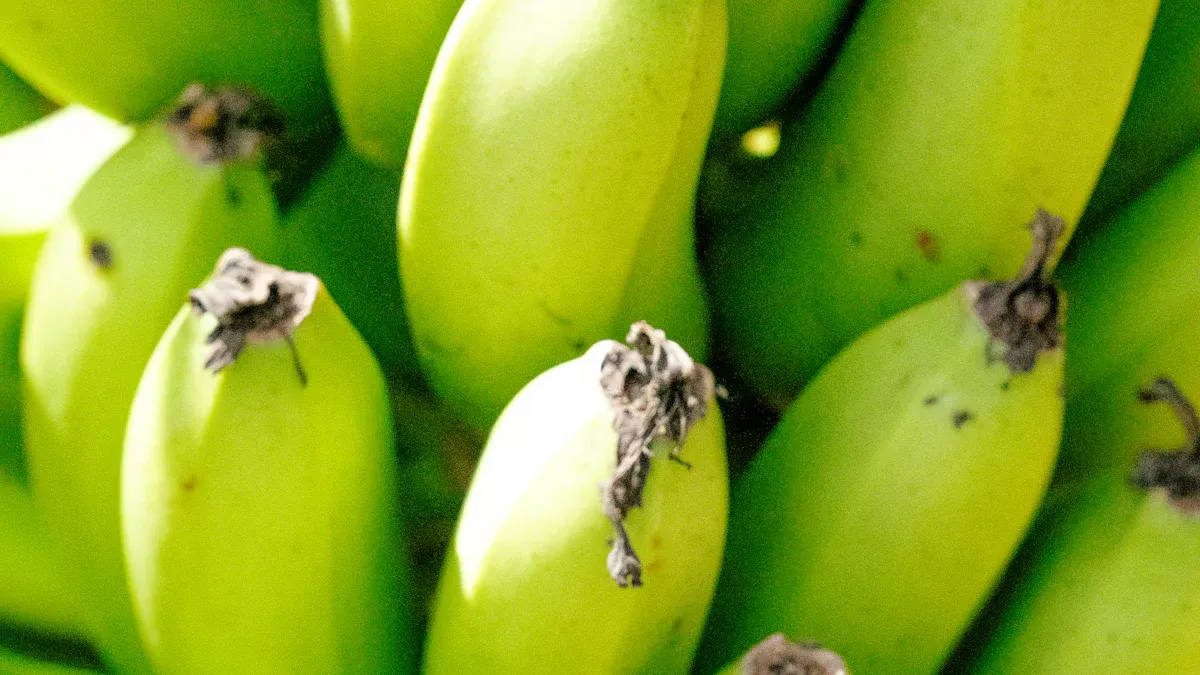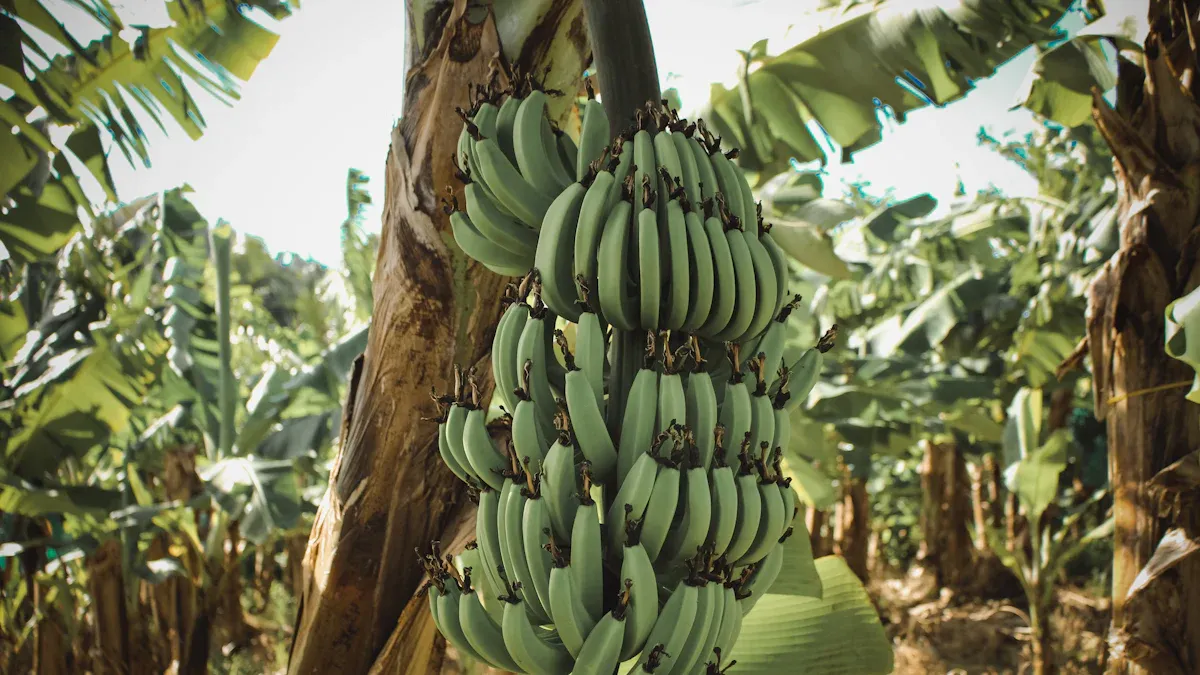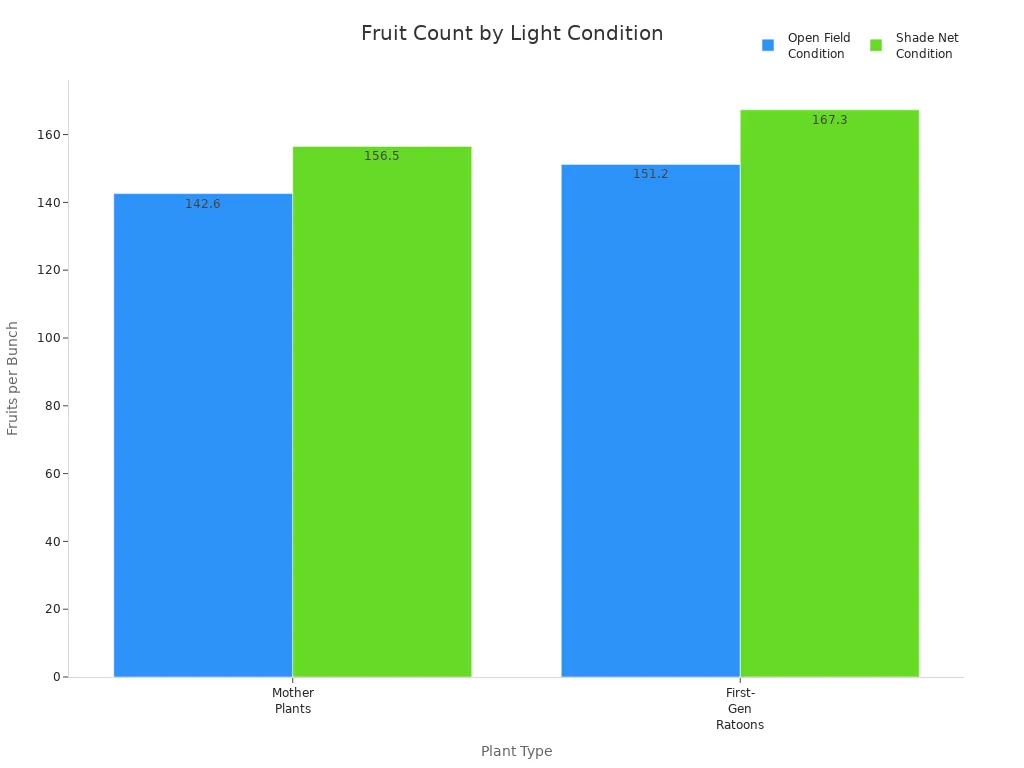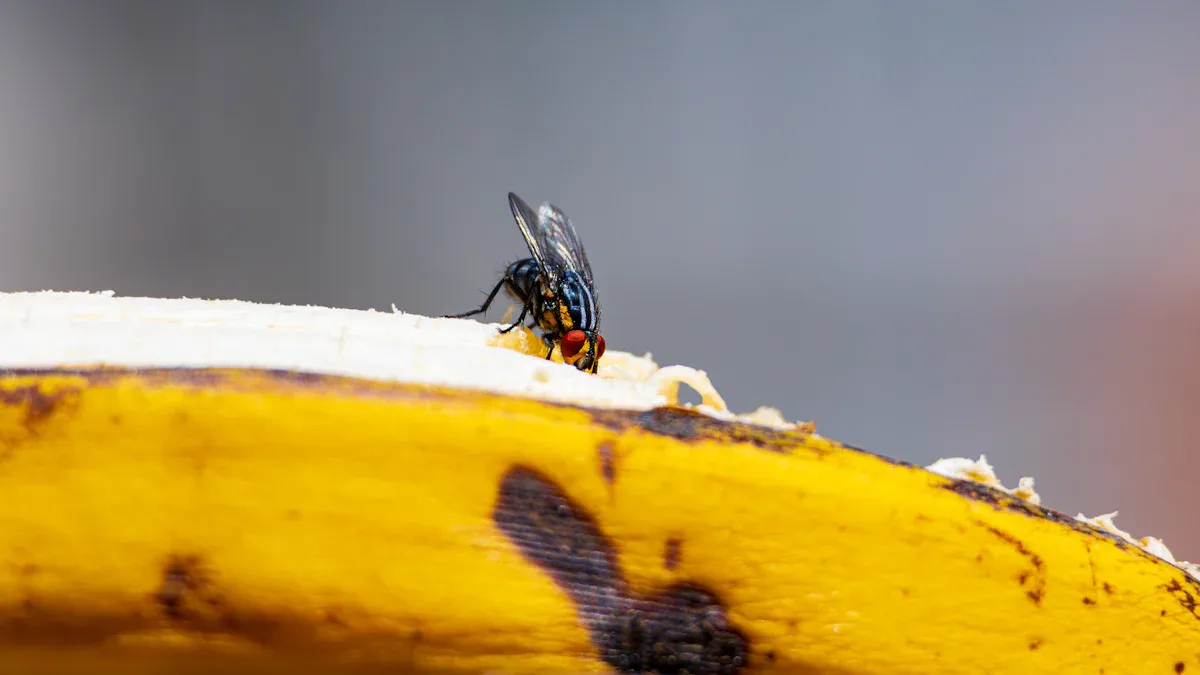
If your Cavendish banana plant is struggling, you’re not alone. Many growers face challenges that lead to plant decline. Common issues include environmental stress, pest infestations, and diseases. Identifying the specific cause is crucial for finding effective solutions. For instance, Panama Disease TR4 poses a significant threat, as this fungus can linger in the soil for decades.
Key Takeaways
Ensure your Cavendish banana plant receives at least six hours of sunlight daily for healthy growth and fruit production.
Maintain humidity levels between 50-70% to prevent leaf curling and fungal diseases.
Regularly inspect your plant for pests and diseases, and act quickly to protect its health.
Environmental Issues

Cavendish banana plants thrive in specific environmental conditions. Understanding these factors can help you maintain their health and prevent decline.
Light Conditions
Light plays a crucial role in the growth of your Cavendish banana plant. Ideally, these plants need full sun exposure for about six hours daily. Insufficient light can lead to poor fruit production and weak growth. A study shows that plants in shade conditions produced 10% more fruits per bunch compared to those in open fields. Here’s a quick comparison:
Measurement | Open Field Condition | Shade Net Condition | Change (%) |
|---|---|---|---|
Number of fruits per bunch | 142.6 | 156.5 | +10% |
Fruit weight | N/A | Increased by 15.5% | N/A |

Temperature Stress
Temperature significantly impacts your Cavendish banana plant’s health. These plants prefer temperatures between 15-35°C. Stress occurs when temperatures drop below 12°C or rise above 38°C. Symptoms of temperature stress include yellow leaves and stunted growth. Here are some key points to remember:
Below 12 °C: Peel turns brown, and ripening stalls.
Above 25 °C: Bananas may not develop an even yellow peel.
Humidity Levels
Humidity is another vital factor for your Cavendish banana plant. The ideal humidity level ranges from 50-70%. Low humidity can cause leaf curling and browning, while high humidity can lead to fungal diseases. Here’s how humidity affects plant health:
Humidity Level | Effect on Plant Health |
|---|---|
50-70% | Ideal for vitality |
Below 50% | Leaf curling and browning |
Above 70% | Fungal diseases and leaf rot |
Maintaining proper humidity levels is essential. Consider using a humidifier during dry months to keep your plant healthy.
Common Pests

Cavendish banana plants face threats from various pests. Identifying these pests early can help you protect your plants and ensure their health.
Pest Types
Several pests commonly affect Cavendish bananas. Here are some of the most recognizable ones:
Banana Weevil: This pest burrows into the plant’s pseudostem, causing significant damage.
Aphids: These small insects suck sap from the leaves, weakening the plant.
Spider Mites: These tiny pests create webs and can lead to leaf discoloration.
Banana Skipper: The larvae of this moth feed on the leaves, causing visible damage.
Symptoms of Infestation
You should watch for specific symptoms that indicate pest infestations. Here’s a table summarizing the most recognizable signs:
Symptoms | Description |
|---|---|
Leaf yellowing | Symptoms appear similar to drought, indicating stress on the plant. |
Withering outer leaves | A sign of damage that can be associated with pest activity. |
Leaf discolouration | Black or dark brown spots are common indicators of pest presence. |
Leaf rolling | Visible damage caused by banana skipper larvae. |
Excessive burrowing | Damage from banana weevils can be easily observed. |
If you notice these symptoms, it’s essential to act quickly to prevent further damage.
Treatment Solutions
Effective treatment methods can help you manage pest populations on your Cavendish banana plants. Research shows that combining preventive and chemical control strategies works best. Here are some tips:
Preventive Measures: Thinning out dense foliage can improve air circulation. This reduces the likelihood of pest infestations.
Chemical Treatments: Use pesticides specifically designed for banana plants. Follow the instructions carefully to avoid harming beneficial insects.
Fallow Periods: Implementing fallow periods can help manage pests like Radopholus similis, a nematode affecting banana plants. This method is environmentally friendly and sustainable.
By staying vigilant and applying these treatment solutions, you can protect your Cavendish banana plants from pests and ensure their continued health.
Diseases
Cavendish banana plants face several diseases that can lead to significant health issues. Understanding these diseases helps you take proactive measures to protect your plants.
Fungal Infections
Fungal infections are among the most serious threats to Cavendish bananas. Two notable fungal diseases are Fusarium wilt and Panama disease. Here’s a table summarizing their symptoms:
Fungal Infection | Symptoms |
|---|---|
Fusarium wilt | Yellowing and wilting of leaves, internal stem discoloration, and eventual plant death. |
Panama disease | Dark stain at the stele-cortex junction, reddish-brown xylem, yellowing and wilting leaves. |
Panama disease, specifically Tropical Race 4 (TR4), poses a severe threat to global banana production. This disease affects over 80% of banana plantations worldwide. It threatens not only Cavendish bananas but also important plantain cultivars that feed approximately 400 million people. The resurgence of TR4 raises concerns similar to those during the ‘Gros Michel’ era, highlighting the ongoing vulnerability of this crucial crop.
Bacterial Issues
Bacterial pathogens can also cause significant decline in Cavendish banana plants. The primary culprit is Fusarium oxysporum f. sp. cubense (Foc), which leads to Fusarium wilt. This pathogen can survive in the soil for decades, infecting the roots and causing wilting and death. Other bacterial pathogens include Ralstonia solanacearum and Ralstonia syzygii ssp. celebensis. These bacteria can severely impact plant health.
To manage bacterial diseases effectively, consider these tips:
Use clean planting material to avoid introducing bacterial diseases.
Implement sanitation practices by regularly disinfecting farm tools and equipment.
Remove male flowers early and bag fruit clusters to prevent insect transmission.
Apply area-wide control measures to limit access to infected fields.
Regularly uproot and dispose of infected mats to control disease spread.
Rotate crops or allow fallow periods to reduce pathogen populations in the soil.
Successful sanitation programs have shown that proper practices can significantly reduce disease intensity.
Viral Concerns
Viral diseases also threaten Cavendish banana plants. The Banana Bunchy Top Virus (BBTV) is one of the most concerning. It causes dark green streaks on leaf veins, narrow and bunched new leaves, and stunted growth. Other viral diseases include Panama disease and Sigatoka disease, which can lead to yellow streaks on lower leaves and dark brown or black spots.
The spread of these viral diseases has severe implications for banana production. For instance, the impact of TR4 on Cavendish banana production threatens food security and the livelihoods of millions. In Mozambique, a single commercial farm lost nearly USD 80 million in four years due to TR4, leading to job losses for 3,000 workers. This highlights the extensive economic repercussions of viral diseases on banana production.
By understanding these diseases and their symptoms, you can take steps to protect your Cavendish banana plants and ensure their health.
Care Mistakes
Watering Errors
Watering your Cavendish banana plant correctly is crucial. Over-watering can lead to root rot, which poses a significant threat to your plant’s survival. Symptoms include yellow leaves, wilting, and a mushy stem. On the other hand, under-watering causes browning and drying of the leaves. This can stunt growth and may even lead to the plant’s death if not addressed. To maintain optimal health, consider these tips:
Water your Cavendish banana plant with 0.5 cups every nine days when not exposed to direct sunlight.
Monitor container-grown plants to ensure they do not dry out. Water when the soil is dry down to ½ inch below the surface.
Nutrient Deficiencies
Nutrient deficiencies can also harm your Cavendish banana plant. Low levels of potassium, magnesium, nitrogen, or sulfur can cause yellowing of leaves. Here’s a table summarizing common nutrient deficiencies and their symptoms:
Nutrient | Symptoms |
|---|---|
Potassium | Browning of leaf margins, yellowing of leaves, stunted growth, skinny trunks |
Nitrogen | Stunted plants, chlorosis in older leaves, weak roots, few or no keiki |
Magnesium | Browning, chlorosis, growth retardation |
To prevent these issues, manage your nutrients carefully. Split applications of fertilizers can minimize losses, especially for nitrogen and potassium. Apply potassium before peak flowering for the best results.
Pruning Techniques
Improper pruning can create wounds that allow pathogens to enter, increasing the risk of diseases. It can also stress your plants, weakening their defenses. Follow these best practices for pruning:
Pruning Technique | Best Time to Prune | Additional Tips |
|---|---|---|
Spring | Ideal for new growth | Remove new suckers to focus energy on vertical growth. |
Year-round | Anytime | Trim brown or dying leaves to maintain health and aesthetics. |
Tool hygiene | Anytime | Use sharp, sanitized tools to prevent disease and ensure cleaner cuts. |
By avoiding these common care mistakes, you can help your Cavendish banana plants thrive and produce healthy fruit.
Understanding the causes of decline in your Cavendish banana plant is vital. Here are some key takeaways to help you:
Utilize allicin to boost disease resistance against Fusarium wilt.
Monitor sunlight, soil, and watering needs for optimal growth.
Regularly check for pests and diseases to maintain plant health.
Stay proactive in your care, and seek more information as needed!
FAQ
What should I do if my Cavendish banana plant has yellow leaves?
Yellow leaves often indicate over-watering or nutrient deficiencies. Check your watering schedule and consider fertilizing with potassium.
How can I tell if my banana plant has pests?
Look for signs like leaf discoloration, wilting, or webbing. Inspect the undersides of leaves for small insects.
What is the best way to prune my Cavendish banana plant?
Prune during spring to encourage new growth. Remove dead leaves and suckers to focus energy on the main plant.

